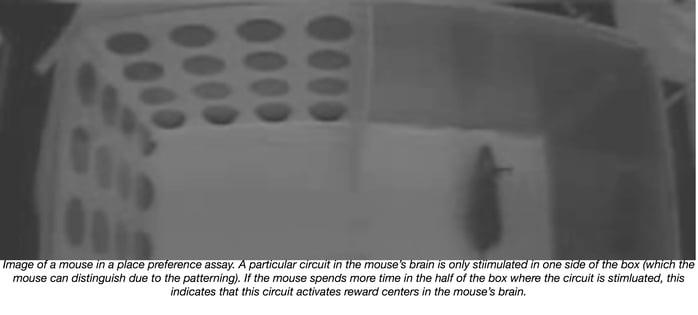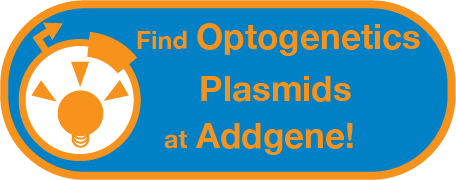This post was contributed by guest blogger Derek Simon.
The actual experiments you do will be determined by the topic you’re interested in studying, but, in today’s post, we’ll discuss some of the important considerations you should think about when developing optogenetics behavioral experiments. There are far too many behaviors that have utilized optogenetics to be fully summarized in a short blog post, but some examples I’m personally interested in include: intracranial self-stimulation (ICSS) and place preference. The lab I work in (the Kreek lab) focuses on the neurobiology of addictive diseases, which means we are interested in circuits that mediate drug taking behavior. If a circuit reinforces behavior (activation of the circuit promotes subsequent, repeated activation), this is an approximation of reward or the sense of pleasure that the animal perceives through taking a drug. The ideal behaviors to test reinforcement are ICSS and place preference.
Historically, ICSS was done by implanting an electrode and non-specifically electrically stimulating an ill-defined region of the brain. With the advent of optogenetics, ICSS can now be done with neuronal cell-type and temporal precision. In ICSS, a test chamber is used in which a nose-poke at a particular hole (the active hole) induces laser stimulation of the chosen brain circuit, while a nose-poke at a separate hole (inactive hole) does not. If activation of the circuit is sufficient to induce reinforcement (instills a sense of “reward”), then the animal will repeatedly nose-poke at the active hole [1, 2].
Place preference/place aversion also models reinforcement but is considerably simpler than ICSS. The test chamber is divided into two halves that are distinguished visually through different patterns and the animal only receives stimulation in one of the two chambers (see image below). If a circuit is reinforcing, the animal will prefer to spend most of its time in the chamber in which it receives the stimulation (conversely, if the circuit is aversive, it will spend most of its times in the opposite chamber) [2]. Laser activation is usually controlled automatically using motion capture software such as EthoVision.

Consult the literature to find all the applications of optogenetics relevant to your field. Ultimately, your question should dictate your behavioral output. However, regardless of the type of behavior, certain technical considerations still apply.
Testing stimulation
First, In lieu of electrophysiology, it would be convenient to know if you are actually stimulating or inhibiting the targeted neuronal population prior to behavioral testing. One method to determine this is to examine expression of the early response gene c-fos. For example, using Chr2 stimulation should result in robust increases in c-fos expression in the targeted brain region after stimulation compared to controls without Chr2. c-Fos is a reliable and widely used molecular marker of neuronal activation and is a sufficient readout to proceed with your behavioral experiments. Comparison of c-fos amongst animals that receive different types of stimulation may help to refine and optimize your stimulation parameters as well.
Inhibition of neuronal activation is a little more complicated since basal neuronal activity in your brain region of interest could be low or highly variable without the behavioral test. Another readout may be necessary to prove inhibition of neuronal activation, but it may still be possible to use c-fos expression to get the evidence you need. For example, as shown in this study [3], hippocampal neurons are activated when the mouse is placed in a novel context. As a proof-of-principle test, the authors were able to show that HR blocked neuronal activation in the novel context as determined by reduced c-fos expression, thus showing successful inhibition of hippocampal neurons.
Initial monitoring
Second, this may sound rudimentary, but before you do any type of behavior analysis, simply take a few animals and stimulate them for 30min to an hour and observe what happens. You never know how stimulation of a particular brain region may affect the animal; stimulation could induce seizures or some other unwanted phenomenon or it could reveal something fascinating. Behavior is based primarily on careful observation of what an animal does naturally so, after all the optimization, turn on the laser and watch what happens. Who knows, you may observe something that could move your project onto the exciting—and unanticipated—road of discovery.
Monitoring behavioral output
The appropriate behavioral readout for your optogenetics experiment is contained within the hypothesis you are testing. In other words, your optogenetic experiment should be designed around a behavioral test in which your circuit of interest is putatively involved in regulating the behavioral output. For example, if you are interested in studying a brain region that may be important in memory, an appropriate behavioral test might be contextual fear conditioning (reviewed in [4]). Contextual fear conditioning is a behavioral experiment in which an animal is trained to “freeze” upon anticipation of a mild electric foot shock that has become associated with a visual or auditory cue. The hippocampus has long been known to be responsible for mediating this behavioral effect but the function of specific subregions within the hippocampus were only recently studied in detail thanks to optogenetics. In Goshen et al, inhibition of the CA1 region using HR was found to block the acquisition and retrieval of contextual fear memories [5]. In a modified behavioral paradigm, the authors found that precise but not prolonged inhibition of CA1 neurons attenuated conditioning, which suggests that other regions of the brain may be involved in retrieval of remote contextual memories. This study is an excellent example in which the authors started with a brain region that was known to be generally associated with a specific behavior but that they more precisely characterized with spatial (CA1), temporal (real-time inhibition), and behavioral (remote memory retrieval) specificity. Optogenetics can be used to more precisely associate regions of the brain with many known behaviors. However, if you observe no difference in your behavioral output with optogenetic manipulation, this can be explained primarily in two different ways 1) your hypothesis is wrong or 2) there is some problem with the technical implementation of your optogenetics setup (viral expression, efficiency of laser light transmission to the target neurons, appropriate stimulation parameters, etc.) The easiest way to resolve these issues is with electrophysiology.
Concluding thoughts and moving beyond the mouse
While it sounds like a lot of steps and a lot of room for error, optogenetics is not nearly as difficult as it seems. Like every other advanced technique in neuroscience it has a bit of a steep learning curve and many opportunities for mistakes. The easiest way to learn optogenetics is straight through the source - find a lab within your own neuroscience sub-discipline that has published using the technique and ask if they would be willing to teach you. An essential, yet sometimes overlooked, aspect of scientific research is that the field benefits from collaboration and the exchange of ideas. The rapid spread of optogenetics throughout the neuroscience field is a great example of this; research benefits when the advances of some are shared with all.
Due to the versatility and standardization of genetic tools in the laboratory mouse, most optogenetics is performed in this species. However, transgenic rat technology is improving and may one day reach the sophistication of mouse transgenics. Everything that has been described is intended for the mouse; however, all the steps and technical considerations are directly applicable to the rat [6]. Technical differences include the ferrule implants and patch cables. One huge advantage of using rats is their superiority as behavioral models. Beyond rodents, optogenetics has even been applied to other species such as non-human primates [7, 8], zebrafish [9], and c. elegans [10]. If used properly, optogenetics is sure to teach us much in all of these species.
Happy experimenting and hopefully optogenetics will help illuminate (is that pun worn out yet?) your research.
 Derek P. Simon received his PhD in Cellular and Molecular Biology from the University of Michigan and he is currently a Postdoctoral Fellow in the lab of Mary Jeanne Kreek at the Rockefeller University. His interests include the role of learning and memory in opioid addiction and science communication/science writing. Derek is also a pianist and an aspiring composer. View his blog drsimonsaysscience.org or follow him on Twitter @derekpsimonphd.
Derek P. Simon received his PhD in Cellular and Molecular Biology from the University of Michigan and he is currently a Postdoctoral Fellow in the lab of Mary Jeanne Kreek at the Rockefeller University. His interests include the role of learning and memory in opioid addiction and science communication/science writing. Derek is also a pianist and an aspiring composer. View his blog drsimonsaysscience.org or follow him on Twitter @derekpsimonphd.
References
1. Stuber, Garret D., et al. "Excitatory transmission from the amygdala to nucleus accumbens facilitates reward seeking." Nature 475.7356 (2011): 377-380. Pubmed PMID: 21716290. Pubmed Central PMCID: PMC3775282.
2. McDevitt, Ross A., et al. "Serotonergic versus nonserotonergic dorsal raphe projection neurons: differential participation in reward circuitry." Cell reports 8.6 (2014): 1857-1869. Pubmed PMID: 25242321. Pubmed Central PMCID: PMC4181379.
3. Kheirbek, Mazen A., et al. "Differential control of learning and anxiety along the dorsoventral axis of the dentate gyrus." Neuron 77.5 (2013): 955-968. PubMed PMID: 23473324. PubMed Central PMCID: PMC3595120.
4.Mattis, Joanna, et al. "Principles for applying optogenetic tools derived from direct comparative analysis of microbial opsins." Nature methods 9.2 (2012): 159-172.5. Goshen I, et al. Dynamics of retrieval strategies for remote memories. Cell. 2011;147(3):678-89. Pubmed PMID: 22179551. Pubmed Central PMCID: PMC4165888.
6.Witten, Ilana B., et al. "Recombinase-driver rat lines: tools, techniques, and optogenetic application to dopamine-mediated reinforcement." Neuron 72.5 (2011): 721-733. PubMed PMID: 22153370. PubMed Central PMCID: PMC3282061.
7.Diester, Ilka, et al. "An optogenetic toolbox designed for primates." Nature neuroscience 14.3 (2011): 387-397. PubMed PMID: 21278729. PubMed Central PMCID: PMC3150193.
8.Han, Xue, et al. "A high-light sensitivity optical neural silencer: development and application to optogenetic control of non-human primate cortex." Frontiers in systems neuroscience 5 (2011). PubMed PMID: 21811444. PubMed Central PMCID: PMC3082132.
9.Del Bene, Filippo, and Claire Wyart. "Optogenetics: a new enlightenment age for zebrafish neurobiology." Developmental neurobiology 72.3 (2012): 404-414. PubMed PMID: 21567983.
10.Leifer, Andrew M., et al. "Optogenetic manipulation of neural activity in freely moving Caenorhabditis elegans." Nature methods 8.2 (2011): 147-152. PubMed PMID: 21240279. PubMed Central PMCID: PMC3032981.
Resources at Addgene
Topics: Optogenetics, Other, Neuroscience






Leave a Comment